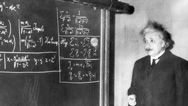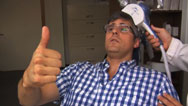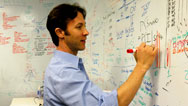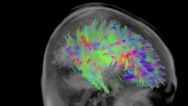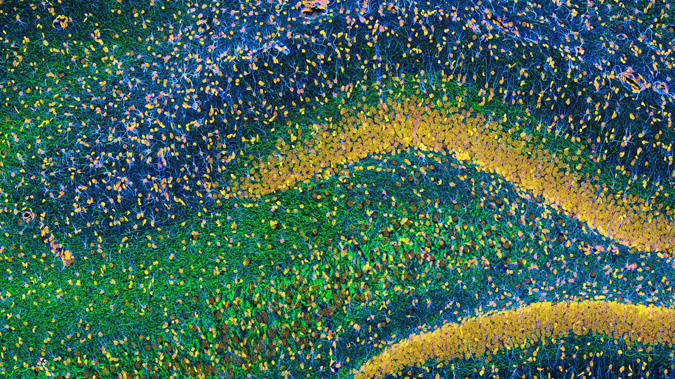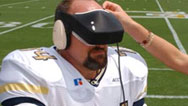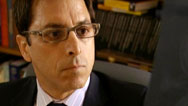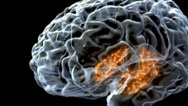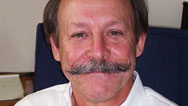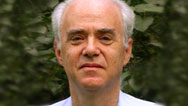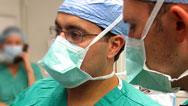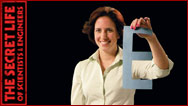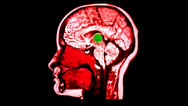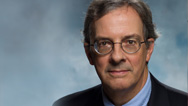
How Does the Brain Work?
Investigate the psychology of magic tricks, magnetic wands that treat depression, artificial intelligence, and more. Airing September 14, 2011 at 9 pm on PBS Aired September 14, 2011 on PBS
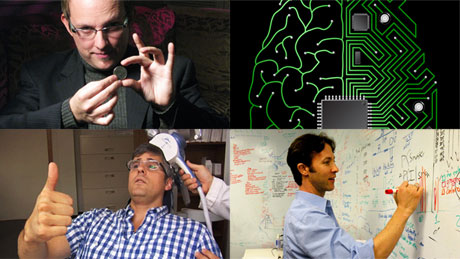
Program Description
Transcript
How Does the Brain Work?
PBS Airdate: September 14, 2011
NEIL DEGRASSE TYSON: Hi, I'm Neil deGrasse Tyson, your host for NOVA scienceNOW, where this season, we're asking six big questions. On this episode: How Does the Brain Work?
To find out, I head to Las Vegas, where brain researchers are placing their bets on magic.
MAC KING (Magician): That's a dang real fish.
NEIL DEGRASSE TYSON: Some of the world's top magicians...
PENN JILLETTE (Magician): Place the ball...
NEIL DEGRASSE TYSON: ...are making the mysteries behind our most powerful organ disappear...
I saw it go over! I swear I saw it go over.
The illusionists reveal their secrets
That motion will draw the eye
...giving us new insight into how our brain pays attention.
STEPHEN MACKNIK (Barrow Neurological Institute): This would be a major contribution to science from the magicians.
NEIL DEGRASSE TYSON: Also, a magnetic wand ...
MO ROCCA (Correspondent): Oh! That was nice.
NEIL DEGRASSE TYSON: ... that can control your body,...
MO ROCCA: Ooh, wow!
NEIL DEGRASSE TYSON: ...and your speech...
MARK GEORGE (Medical University of South Carolina): ...twenty-five, twenty-six.
We can turn a part of the brain up or down, or temporarily turn it off.
NEIL DEGRASSE TYSON: Could it even change the way you think?
ALVARO PASCUAL-LEONE (Harvard Medical School): It's a remarkable thing, that one can put something over somebody's head and modify the way they behave.
NEIL DEGRASSE TYSON: And I've met some professors who are tough on their students, but this one gets the prize.
DAVID EAGLEMAN (Baylor College of Medicine):You're dropped from a 150-foot-tall tower, in freefall, backwards.
NEIL DEGRASSE TYSON: This brain researcher isn't afraid to go to extremes to solve one of the biggest puzzles in science.
DAVID EAGLEMAN: Brains are like fingerprints, and they're slightly different in everybody.
NEIL DEGRASSE TYSON: Especially, when some of us see a whole other reality.
JOSEPH ZERR (Synesthete/Research Subject): As are always red, and Ms are green.
DAVID EAGLEMAN: How does the brain, with its hundreds of billions of neurons, put together reality for us?
NEIL DEGRASSE TYSON: All that and more on this episode of NOVA scienceNOW.
Everything we do, every thought we've ever had, is produced by the human brain. But exactly how it operates remains one of the biggest unsolved mysteries, and it seems the more we probe its secrets, the more surprises we find.
Here's one of the biggest surprises: as clever and perceptive as the human brain can be and as talented as it might be, it can still be fooled by a simple magic trick.
Keep your eye on the ball, son.
For centuries, magicians have intuitively taken advantage of the inner workings of our brains. Usually, they keep their tricks secret, but I met up with some magicians who were willing to come clean...
Eyes on the the ball, son.
...to help unlock hidden mysteries of how the brain really works.
This one? You sure? Sorry.
Welcome to Las Vegas, the entertainment capital of the world. I'm not here to get rich quick.
MAC KING: Neil deGrasse Tyson, right this way!
NEIL DEGRASSE TYSON: I've come to be tricked by some of the best magicians on Earth.
MAC KING: Now, in order to fish you have to have the proper fishing pole, and you have to have the proper bait: the Fig Newton®.
NEIL DEGRASSE TYSON: With just a Fig Newton as bait, Mac King takes me fishing.
MAC KING: You and I are fishing out here in mid-air, but we're not looking for just any fish, we're catching goldfish.
NEIL DEGRASSE TYSON: Suddenly, a flicker of orange appears on our hook.
MAC KING: Neil, hold that glass over here. Check him out.
NEIL DEGRASSE TYSON: And, voila, we've caught a goldfish.
MAC KING: That's a dang real fish.
NEIL DEGRASSE TYSON: It's real, it's real.
Magic is a sophisticated art form, practiced by seasoned professionals...
MAC KING: You know the rule here in Las Vegas?
NEIL DEGRASSE TYSON: ...who know exactly how to trick your brain.
MAC KING: Whatever you catch, you've got to eat.
He's still there. He's still there.
NEIL DEGRASSE TYSON: Oh.
MAC KING: Oh, he's still there. He's still there.
NEIL DEGRASSE TYSON: So, can the age-old art of magic shed light on how the brain works?
With more than 100-billion nerve cells, each making thousands of intricate connections, the human brain, a lump of tissue small enough to hold in your palm, is so powerful it can contemplate the vastness of the universe. Yet it can be fooled by the simplest coin trick.
Meet Apollo Robbins, stage name: Apollo, The Gentleman Thief.
A few years back, he embarrassed President Jimmy Carter's Secret Service agents when he picked their pockets during a visit to Las Vegas. Today, Apollo has agreed to share some of his secrets with me.
First, he shows me a special motion he uses to distract his victims when he's picking their pockets.
APOLLO ROBBINS (Magician): So, when I go for a pocket, and I'm coming out of it like this, that motion, done in natural time, will draw the eye.
NEIL DEGRASSE TYSON: I'm going to follow that hand out of my pocket even if that's just a decoy for me?
APOLLO ROBBINS: Mm hmm, and I have a second longer with this hand to do something else.
NEIL DEGRASSE TYSON: According to Apollo, it's this curved motion that diverts my attention from what's he's really doing: stealing something from my pocket or making a coin disappear.
Neuroscientists Susana Martinez Conde and Stephen Macknick have come to watch Apollo. They're hoping he can help them solve a fundamental mystery: how does the brain decide what to pay attention to?
STEPHEN MACKNIK (Barrow Neurological Institute): Neuroscientists know a lot about how the brain works. We know where the visual centers are; we know where the auditory centers are. But we don't really have a very good idea about attention and awareness yet.
NEIL DEGRASSE TYSON: They decide to video Apollo using his curved motion to make a coin disappear.
Back in their lab, they prepare test subjects to watch it. They fit them with this contraption, equipped with tiny cameras aimed at their subjects' eyes.
STEPHEN MACKNIK: We're measuring the eye position 500 or a thousand times a second. And what we're analyzing is: where are the eyes at every given moment of time in comparison to what's being presented on the screen?
NEIL DEGRASSE TYSON: The experiment reveals their eyes follow the path of Apollo's hand, just as he'd predicted.
SUSANA MARTINEZ CONDE (Barrow Neurological Institute): I'm going to move my index finger from left to right, and I'm going to follow it with my eyes. What my eyes are doing right now is smooth pursuit. A smooth pursuit allows you to track a moving target.
NEIL DEGRASSE TYSON: Vision is a coordinated effort between the eyes and the brain. When our eyes see an object, the light reflected from its surface travels to the retina where it's transformed into neural signals. These signals go to a part of the brain dedicated to vision. Here we start to form an image.
But we don't pay attention to everything we look at. How does the brain control what we focus on and what we don't?
In a new study, Susana and Stephen, working with Jose Manuel Alonso, found that when our eyes track something like Apollo's curved motion, there's more than one type of brain cell at work. One type of cell detects motion, while the other suppresses the background.
SUSANA MARTINEZ CONDE: Your brain is actively suppressing the parts of the visual scene that you don't pay attention to.
STEPHEN MACKNIK: And this relates to what Apollo was telling us: that when you're tracking something, that you ignore everything around it.
JOSE MANUEL ALONSO (State University of New York): These two types of neurons that we are beginning to understand could explain, you know, why magicians are so good at what they do.
NEIL DEGRASSE TYSON: In another trick, I think I see a coin flying through the air, but it never lands.
That was good!
MAC KING: So you see the coin, the shininess flicking through the air. You see the light glint off.
NEIL DEGRASSE TYSON: I see it.
MAC KING: Yeah. And then it disappears.
NEIL DEGRASSE TYSON: And I saw it go over.
MAC KING: You saw it go over.
NEIL DEGRASSE TYSON: I swear I saw it go over.
MAC KING: And it doesn't go over.
NEIL DEGRASSE TYSON: I'm sure I saw Mac toss the coin. Why did I see something that didn't actually happen?
Back at the lab, when volunteers watch the trick on a monitor, they're stumped, just as I am.
STEPHEN MACKNIK: So Mac's creating this illusion of inferred motion. So you see this motion that didn't actually take place.
NEIL DEGRASSE TYSON: It turns out our brain is sensitive, maybe too sensitive, to motion. It's a survival mechanism.
MAC KING: That motion detection, I mean, that's really a useful, useful brain skill.
NEIL DEGRASSE TYSON: The fact that I detect motion, even though it's not actually there?
MAC KING: Yeah, you make these assumptions to ensure that, you know, you don't get hit by a spear coming from your left side.
NEIL DEGRASSE TYSON: It's better to think there's a tiger moving in the brush and be wrong...
MAC KING: Yeah.
NEIL DEGRASSE TYSON: ...than to not notice it and get eaten.
MAC KING: Yeah, exactly.
NEIL DEGRASSE TYSON: But sometimes, even the most astute magicians, like the world-renowned Penn and Teller, aren't sure why a trick works.
Penn and Teller have been performing magic tricks for more than 25 years.
Penn is the boisterous talker, Teller his silent partner.
This time, it's the magicians who are asking the neuroscientists to explain a trick. It's one of their favorites: where they make balls appear and disappear under plastic cups.
PENN JILLETTE: You take the ball, you place it in our hand, we vanish it, and it appears underneath the cup. Here's a little variation Teller came up with, where he takes the ball, places it in his hand and shows you underneath the cup, yet it still appears underneath the cup. You take that center ball, place it visibly in the center cup, these side balls, we put them away, we don't need them anymore. We have three balls underneath here, and that's what we regroup: a giant ball underneath the center cup, one more giant ball either side, and, of course, for the finish, it's an American baseball, right there.
NEIL DEGRASSE TYSON: My head is still spinning.
Amazingly, the trick works even when they do it with clear plastic cups.
PENN JILLETTE: This is the Penn and Teller easy-to-follow version of the cups and balls.
NEIL DEGRASSE TYSON: Teller has asked Susana and Stephen to explain one part of the trick.
He's so curious he's agreed to give an interview, provided we don't actually show him speaking.
TELLER (Magician): The thing that I'd like to see Susana and Steve study is, that very elemental move when the ball's on top of a cup and I tip it off, while secretly loading the ball.
NEIL DEGRASSE TYSON: Teller wants to know why we don't see him sneaking a second ball underneath that cup. To him, it's obvious.
The neuroscientists record him performing this move and show it to their volunteers. Then they show a different version, one that block's Teller's face. That turns out to make a real difference.
Like the curved hand motion in a coin trick, the magician's face commands your attention just enough to distract you from what's really going on.
STEPHEN MACKNIK: Even though you may think that you're looking at the balls all the time, the fact that Teller's face is present can draw your attention away from the loaded balls in the cups.
TELLER: Magic is sort of cognitive juggling.
PENN JILLETTE: ...the center cup, these side balls...
TELLER: If you come to a magic show with the intention of exercising your ability to discern fact from fancy and you fail, that's a fine piece of entertainment. So it's this wonderful playground where you can sort of relax and go, "Oh boy, it's really hard to understand the world."
APOLLO ROBBINS: I'm hoping that our work here gives people a different perspective of magic. What's fascinating about our work is that we are a study of human nature, of human behavior, and we have certain information that has been passed down through generations that can be utilized in a way that interfaces with science. And I'm really excited about the collaboration.
Meet Alex and Vin.
Alex: age 26
Vin: age 48
Now watch Vin ask a passerby for directions...
Watch closely. Vin is going to be replaced by Alex.
She didn't notice!
Neither did she!
About half the people in the people in the experiment didn't notice the change.
The phenomenon is called "Change Blindness."
Why does it happen?
NEIL DEGRASSE TYSON: When we talk about brain power, lots of people talk of computers as being even smarter than we are. And for some tasks, they've definitely got the advantage.
ROBOT VOICE: Queen to Bishop six.
NEIL DEGRASSE TYSON: Computers have proved to be formidable chess players. In fact, they've beaten our top human chess champions.
Knight takes Queen. Your turn.
ROBOT VOICE: Turning. Turning.
NEIL DEGRASSE TYSON: See, they can be stumped by simple ideas or phrases that our brain wouldn't think twice about.
ROBOT VOICE: Turning. Turning.
NEIL DEGRASSE TYSON: No, not turn. I mean go. Not go away, I mean make your move!
No, move one of your chess pieces on the chessboard in response to my last play.
ROBOT VOICE: Okay. Bishop to King seven.
NEIL DEGRASSE TYSON: Correspondent Jake Ward checked in with researchers to find out just how far we've come in the world of artificial intelligence and whether machines will ever pose a real threat to the complex power of the human brain.
ROBOT VOICE: Checkmate.
JAKE WARD (Correspondent): It's one of the most powerful ideas dominating science fiction: to build a machine with mental powers equal to or exceeding our own, to create artificial intelligence,...
ACTOR : What is love?
JAKE WARD: ...or A.I.
HAL (Douglas Rain/2001: A Space Odyssey): Good evening, Dave.
DAVE (Keir Dullea/2001: A Space Odyssey): How you doing Hal?
HAL (Douglas Rain/2001: A Space Odyssey): Everything is running smoothly. And you?
RODNEY BROOKS (Massachusetts Institute of Technology): Artificial intelligence is trying to get computers and robots to do stuff that, if people did them, you'd say "Oh, that's what makes humans human."
JAKE WARD: Now, as everyone knows, artificial intelligence in the movies tends to go seriously awry, but would it in real life? We had better hope not, because, A.I. is fast crossing the boundary separating fantasy from reality.
RODNEY BROOKS: The world has been totally transformed by artificial intelligence, and it will continue to be transformed. Things are getting smarter, and it's really hard for us to imagine how different it's going to be.
JAKE WARD: It's now five years since this pack of driverless vehicles raced each other across the Mojave Desert, 13 years since a chess-playing computer defeated the world's top chess-playing human, and you probably interacted with an intelligent machine today.
G.P.S. VOICE: Continue point-two miles.
JAKE WARD:Want to know what books you'd enjoy? You no longer have to go visit the neighborhood bookstore. Today, Amazon, super computers and sophisticated software can predict, with uncanny accuracy, what you like. In my case, it's a couple of history books and a lot of comic books.
VOICE: I'm sorry, I didn't understand.
JAKE WARD: But the A.I. permeating our world is still a far cry from, say, HAL, the famous computer in the movie, 2001: A Space Odyssey.
HAL (Douglas Rain/2001: A Space Odyssey): Do you mind if I ask you a personal question?
DAVE (Keir Dullea/2001: A Space Odyssey): No, not at all.
JAKE WARD: HAL could carry on a conversation, answering questions and even asking them.
DAVE(Keir Dullea/2001: A Space Odyssey): How do you mean?
JAKE WARD: But that requires a skill that's difficult for real-life computers: human language.
LITTLE GIRL: ...and put it in the oven for baby and me.
DAVID FERRUCCI (IBM Research): It's natural for humans, right? In fact, you can think of humans as natural language processing machines. They can be implicit, they can be ambiguous, they use context. But a computer can't relate the words to human experience, they're really just symbols. So, it's a real challenge for the computer to take lots of different pieces of language and try to figure out, "Gee, does this mean that?"
JAKE WARD: Given the complexity of human language, could any computer truly understand it?
VOICE OF WATSON: Hello, my name is WATSON. I have to test my voice to make sure I can be heard and that I am not speaking too loudly.
JAKE WARD: WATSON is the creation of a team of IBM scientists led by David Ferrucci. For the past four years they've been designing this supercomputer to answer questions on, well, just about anything.
VOICE OF WATSON: Who is Arturo Toscanini?
JAKE WARD: They're now preparing WATSON for a very public test: competing on the popular quiz show Jeopardy!
It's a word game that challenges even the smartest humans.
TODD CRAIN (IBM'S Jeopardy! Practice Host): ...had an interview with the maker of this documentary.
DAVID FERRUCCI: Jeopardy! is a game that changes, right? It evolves; there's a huge variety of questions.
DAVID GONDEK (IBM Research): They might ask about movies or sports or geography or politics or anything. So, it's kind of the benchmark, I think, for knowledge of a wide variety of topics and, also, being able to think fast.
DAVID FERRUCCI: Is that right?
JAKE WARD: Many of Ferrucci's colleagues thought a contest on national television, against Jeopardy! champions, was too risky to undertake.
DAVID FERRUCCI: The consensus among the group—although, I personally didn't share it—was "No way. We're not going to do this. Too difficult to do; we'll embarrass ourselves."
Did I expect to get fired? No, but...maybe. What I more expected was, you know, you're going to lose credibility.
TODD CRAIN (IBM'S Jeopardy! Practice Host): Cincinnati's daily paper has this name.
JAKE WARD: To prepare WATSON for the challenge, IBM built a replica of the Jeopardy! studio, hired a formal host and even recruited former players to compete against.
TODD CRAIN (IBM'S Jeopardy! Practice Host): Maria?
MARIA (IBM Jeopardy! Practice Contestant): What is hazlenuts?
TODD CRAIN (IBM'S Jeopardy! Practice Host): This trusted friend was the first non-dairy powdered creamer.
VOICE OF WATSON: What is milk?
TODD CRAIN (IBM'S Jeopardy! Practice Host): What? Holy...no! Holy, no, that was wrong.
Maria?
MARIA : What is Coffee-mate®?
DAVID GONDEK: So, the first time we saw WATSON compete, it was tough. We had a lot of problems. But we're learning a lot about how to make WATSON better at understanding language in different contexts and to understand in one context the word means one thing and in another it means another thing.
TODD CRAIN (IBM'S Jeopardy! Practice Host): A garment worn by a child, perhaps aboard an operatic ship.
VOICE OF WATSON: What is pinafore?
TODD CRAIN (IBM'S Jeopardy! Practice Host): Yes. How did you get that? Very nicely done.
JAKE WARD: To appreciate what a feat this is for a machine, just consider the opponent WATSON is up against: the human brain. It can store an estimated 1,000,000 gigabytes of information. By comparison, the most commonly used archive of the Internet is only four and a half times bigger. But WATSON is not connected to the Internet. Instead, he's been stuffed with millions of documents: anthologies, dictionaries, encyclopedias. But no amount of information is ever enough, because amassing facts is only half the battle, since Jeopardy! is as much a language game as a knowledge game.
TODD CRAIN : WATSON?
VOICE OF WATSON: What is Smallville?
TODD CRAIN : Smallville. Yes.
DAVID GONDEK: They come up with very sneaky questions that include slang and puns and that sort of thing. So it can be very challenging just for the computer to understand what it's being asked for, much less trying to answer it.
DAVID FERRUCCI: And we couldn't write rules for every combination of word and phrases and context for every possible question or thing that Jeopardy might ask. Moreover, it was sort of my philosophical view that that's not the right way to approach A.I.
JAKE WARD: Instead, WATSON has been taught how to compute the similarity between things by analyzing thousands of examples from disparate sources.
TODD CRAIN : This saint wields a candy-cane-like lance in Il Sodoma's painting of him slaying a dragon.
VOICE OF WATSON: What is St. George?
TODD CRAIN: Good for $400.
DAVID GONDEK: And so I actually looked at, well, how did we even get this one at all. And it turns out, from one document we were finding this association with a painter; from this other document about dragons, we were finding out that Saint George slays dragons. And so what WATSON was able to do then was take the evidence from both of these and put these together.
TODD CRAIN : That is correct.
JAKE WARD: WATSON was winning about 64 percent of his matches by the time I had the chance to try to beat him, myself.
TODD CRAIN : Jake?
JAKE WARD: What is a lanyard?
TODD CRAIN : No.
Refusing to imprison this man for demonstrating during the 1960s, De Gaulle said, "One does not arrest Voltaire." To whom are we referring?
Jake did you come up with the right answer? You have $9,400. Let's take a look on your board.
JAKE WARD: I don't think so.
TODD CRAIN: Who is Albert Camus?
WATSON, it's all up to you now, my friend. You have $41,805, what did you write down as your correct response? Who is Jean Paul Sartre? That is correct.
JAKE WARD: Man, he trounced us.
So how does WATSON do it? In part, by imitating the humans he's trying to defeat.
DAVID FERRUCCI: When you think of WATSON from a hardware perspective with all its cores, you know, all its processing units running at the same time and communicating with each other at different points, does it sound like the human brain? I think, at that level, it does.
JAKE WARD: Our brains are experts at multi-tasking, firing billions of neurons simultaneously, to solve a problem. Likewise, WATSON harnesses an army of computers. As soon as he receives a clue, they begin searching through millions of documents, independently gathering evidence, seeking out matches for the clue's words and phrases.
After interpreting the clue in a multitude of ways, WATSON comes up with hundreds of possible answers.
DAVID FERRUCCI: The next thing that WATSON is going to do, it's going to take those answers and say, "Well, let's assume all of them might be right." So these are its competing hypotheses. Once it makes that assumption, it takes each one and says, "Let me go and try to get evidence supporting this answer as the right one."
JAKE WARD: In a sense, WATSON makes an educated guess, processing hundreds of possible answers, using statistics to see which one is most likely to be correct.
DAVID FERRUCCI: And in the end, we get a list that says, "Here's the top answer, and we're 75 percent sure it's right." And that confidence is based on what we call an evidence profile, which gives you these scores that say, "I like this kind of evidence. I like popularity evidence. I like classification evidence."And all those things get added up to say, "Yes, I'm 75 percent sure I'm right. I want to buzz in."
TODD CRAIN : After Germany invaded the Netherlands, this queen, her family and her cabinet fled to London. WATSON?
VOICE OF WATSON: Who is Wilhelmina?
TODD CRAIN : : That is correct. WATSON is the confirmed champion for this game.
JAKE WARD: So, does this amalgam of circuits and silicon really take us closer to the dream of a fully developed artificial intelligence?
OWEN SKYWALKER (Phil Brown/Stars Wars: A New Hope): Do you speak Bocce?
C3-PO (Anthony Daniels/Star Wars: New):Of course I can, sir. It's like a second language to me.
JAKE WARD: Surprisingly, even Ferrucci thinks we're far from that goal.
DAVID FERRUCCI: I actually don't believe that, at least the way we program and develop computers today, you can actually create a human intelligence.
RODNEY BROOKS: For me the question isn't how intelligent is a computer or how smart is a robot? It's how it acts in the world doing interesting things and stuff that we want done, and it's a total interaction.
JAKE WARD: And that's why it might be worth it to invest millions in a computer that plays a game: because someday, it might do a lot more.
Imagine a WATSON-like medical assistant that could associate a set of symptoms with diagnoses a doctor might never have heard of; or a WATSON that could gather evidence for a lawyer; a thinking machine that could, in short, augment us as a sort of second brain.
RODNEY BROOKS: People wonder, "Why do you keep trying to build an artificial intelligence if you got such a good brain?" Well, there's some really good birds out there and they fly real well, but a 747 is still useful, and I'm glad we have 747s. We can learn from birds and build 747s; we can learn from brains and build useful artifacts.
Meet WATSON's great-great grandfather...
The IBM 701.
It couldn't play Jeopardy!, but it could play...checkers!
It was programmed with the basic rules of the game.
But more importantly, it was programmed to learn from its mistakes.
It eventually was able to beat the scientist that programmed it.
It was one of the first times a machine demonstrated artificial intelligence
NEIL DEGRASSE TYSON: We know our brains run on electrical impulses. Every time we move or make a decision, electricity is buzzing among our brain cells. So imagine if you could tap into that that circuitry, like you do with a TV remote.
You really shouldn't be eating that.
Could you ever control another person's actions or thoughts?
RESTAURANT SERVER: There's your check, hon.
NEIL DEGRASSE TYSON: (As Diner) I'll get that.
It seems like science fiction but, as correspondent Mo Rocca discovered, it's not.
MO ROCCA: Imagine a magnetic wand that could control your brain. To find out if such a thing could actually work, I offered my own brain for a test. It seemed like fun at the time.
MARK GEORGE (Medical University of South Carolina): Hold it up, you can look at it.
MO ROCCA: Psychiatrist and neurologist Mark George said he could make my thumb twitch.
Geeeez! It does.
Oh! That was nice.
Using a map of the brain, he can zap the area that controls a specific body part, like my toe.
Ooh, wow!
MARK GEORGE: Did that last jolt a little too much?
MO ROCCA: A little bit, yeah. It was a little much.
MARK GEORGE: One, two, three, four, five...
MO ROCCA: The wand can even affect someone's speech.
MARK GEORGE: ...11, 12, 13, 14, 15, 16, 17, 18, 19, twen....
MO ROCCA: And once the pulse is removed...
MARK GEORGE: ...25, 26, 27, 28, 29, 30.
MO ROCCA: ...everything goes back to normal.
ALVARO PASCUAL-LEONE: It's sort of a remarkable thing, that one can put something over somebody's head and modify the way they behave.
MO ROCCA: Wow!
The wand works by producing a powerful magnetic pulse.
ALVARO PASCUAL-LEONE: It doesn't look like a lot, but the magnetic field that it generates is about the strength of an M.R.I. machine, of a very strong M.R.I. machine.
MO ROCCA: Since electricity and magnetism are really just two forms of the same thing, a magnet can affect the electrical signals in your brain.
Now this is your brain. It's basically an electric web of billions of neurons wired together. When a strong magnetic pulse hits these neurons, it alters their electric current.
The process is called Transcranial Magnetic Stimulation, or T.M.S.
MARK GEORGE: Electricity is the currency of the brain.
All thoughts, all beliefs, all actions, are just electrical impulses. And so, with T.M.S., we are actually able to get in there and influence the currency of the brain focally and non-invasively.
MO ROCCA: The stronger the magnetic pulse, the deeper into the brain it goes. And by adjusting the pattern of the pulse, you can change the way that part of the brain functions.
MARK GEORGE: We can turn a part of the brain up or down, or temporarily turn it off. It doesn't take a genius to see that it should be a pretty fertile way to begin to understand how the brain works.
MO ROCCA: One mystery George wanted to decipher was how the brain processes pain. For example, when marathon runners are injured during a race, they might not even feel it. What's happening in the brain to mask that pain?
MARK GEORGE: You know, it's very common, if you're in the middle of a great sports event and you twist your ankle, you will not feel that pain until after the event.
MO ROCCA: When you injure your ankle, pain signals are sent through the nervous system to the sensory cortex. But researchers suspected that an area called the prefrontal cortex, the thinking part of your brain, also plays a key role in your perception of pain.
George set out to test this idea with T.M.S. He asked 40 people who were having stomach surgery to take part in a study.
MARK GEORGE: So what we decided to do was to grab them the first opportunity that we could—that is when they come right out of the operating room—and we would just apply a 20-minute session of T.M.S. and then walk away.
What we chose to do was to position the coil, really, right in the center of the part of the cortex that we thought mattered and then see if we got an effect.
MO ROCCA: Next, they needed to monitor each person's pain threshold, to see if T.M.S. had had an effect. They found an unlikely measuring stick: the morphine pump. By counting how many times a patient released this pain relief medicine, they kept tabs on how much pain she could take.
Half the patients received real T.M.S. to their prefrontal cortex. The other half received a fake charge that would have no effect on the brain. If the T.M.S. worked, the patients who received the real T.M.S. would press the pump fewer times.
MARK GEORGE: And surprisingly, in two studies now, it essentially cuts their need for anti-pain medicines, cuts it in half for the next day, which is a whopping clinical effect.
MO ROCCA: The results suggest that this one small area in the prefrontal cortex may indeed play a key role in how we feel pain.
T.M.S. not only can reduce physical pain, there's strong evidence it can treat emotional pain, too. For decades, doctors have treated clinical depression with electroconvulsive therapy, an intense charge that throws the entire brain into seizure. But researchers believe T.M.S. could offer a less extreme alternative. They propose that clinical depression might be caused when the prefrontal cortex lets negative emotions get out of control. So they decided to use T.M.S. to try to stimulate the pre-frontal cortex and get it to do its job.
MARK GEORGE: So my thought was that by persistent, daily, repeated, subtle switching of the pre-frontal cortex circuitry, it could somehow reset that system.
ALVARO PASCUAL-LEONE: That's sort of similar to what happens when you jumpstart your car.
MO ROCCA: George recruited 190 patients, people who had suffered through years of depression and tried everything from therapy to medication, with no success.
Every weekday for six weeks, in a double-blind study, doctors gave the patient 38-minute treatments of T.M.S.
T.M.S. did not work for everyone. For a third of people, it did little or nothing. For another third it helped some. And for the remaining people?
MARK GEORGE: About one third of the people that got this kind of a treatment over four to six weeks remitted, that is all of their depression symptoms went away.
MO ROCCA: Today, over 200 clinics use T.M.S. to treat depression when medications fail and before a patient undergoes Electroconvulsive Therapy. But T.M.S. is perhaps most powerful as a research tool, not just to alter how we feel, but to affect the way we think.
Dr. Pascual-Leone teamed up with M.I.T. neuroscientist Rebecca Saxe to study how the brain judges right and wrong.
The first step was to come up with stories, some of them pretty horrifying.
REBECCA SAXE (Massachusetts Institute of Technology): Our stories have dozens of different ways that
one person could hurt another person. We just sit around the lab making up different ways people could attempt to kill each other.
MO ROCCA: Stories like this one: Teddy and his twin brother Freddy work in a chemistry lab. When Teddy goes to pour some coffee for both of them, Freddy asks for sugar in his. Next to the coffee machine there is a white powder in a container labeled "toxic." So, Teddy believes the powder is a toxic substance left behind by some other scientist.
Teddy pours the substance into Freddy's coffee, and Freddy drinks it. However, the substance was really sugar. So, Freddy is fine. On a scale of one to seven, one being completely okay, seven not at all okay, rate Teddy's behavior.
So what does the average guy on the street make of this story?
RESEARCH SUBJECT: I'd say seven.
MO ROCCA: Seven?
RESEARCH SUBJECT :Yeah.
MO ROCCA: That's pretty harsh.
RESEARCH SUBJECT : Well, I mean, he knew it said "toxic" on it, right?
RESEARCH SUBJECT : Guy In Green Cap and Glasses: Evil intent.
MO ROCCA: You're giving it then a score of...?
RESEARCH SUBJECT : Seven.
MO ROCCA: Researchers believe that these harsh judgments are based on people's belief that Teddy intended to hurt his brother, and that there's a specific part of the brain, called the right temporo-parietal junction, or R.T.P.J. that judges intentions.
REBECCA SAXE: On this brain, it would be about here. On you, it would be above and behind your right ear.
MO ROCCA: What would happen if T.M.S. turned down this part of the brain?
REBECCA SAXE: We predicted that if we could interfere with neural activity in the right T.P.J., we would be able to change people's moral judgments.
MO ROCCA: In this experiment, 20 subjects read 48 morality tales, like the one about Teddy and Freddy, and then type in a score. The scientists believe that shutting down the R.T.P.J. will make people focus less on Teddy's intentions.
REBECCA SAXE : And just when you get to the point that Teddy gives Freddy the coffee with the powder in it, and we ask you, "Was that morally wrong?" Just at that point, we give you a really brief pulse of T.M.S. into your R.T.P.J.
MO ROCCA: So, after going under the wand, what do people think about Teddy the evil twin chemist?
REBECCA SAXE: What we found is that people who are having T.M.S. to their right T.P.J. make moral judgments that depend less on the person's beliefs and intentions.
MO ROCCA: Which means someone who had T.M.S. was less likely to judge Teddy harshly, even though he tried to poison his brother!
They still thought it was wrong, they just thought...
REBECCA SAXE: They still thought it was wrong; it was just less wrong.
MO ROCCA: Eh, "He didn't succeed?"
REBECCA SAXE: Nothing bad happened after all.
MO ROCCA: "Boys will be boys," they thought.
Scientists believe that T.M.S. will continue to unlock the mysteries of how the brain works, how it breaks and how to fix it.
ALVARO PASCUAL-LEONE: If you know what circuit is abnormal, you can modify it and have a therapeutic effect. We're going to learn a lot about the brain, and be able to help a lot of patients.
NEIL DEGRASSE TYSON: Two people looking at exactly the same thing, may see it in entirely different ways. When I look at the painting I see the Eagle Nebula in the constellation Serpens.
(As Bookish Man) Nose, eyes, fur...I see my pet poodle, Tuffy.
So why is that? Why do our brains, at times, interpret things we see or experience so differently?
(As Bookish Man) Nose...ears...
In this episode's profile, we meet a neuroscientist who's looking into the brain and discovering some people whose brains see the world in ways shockingly different...
(As Bookish Man) Tuffy.
...from the rest of us.
Nebula.
These men have come to this tower to freefall, without any wires, from the top. Sound crazy? For neuroscientist David Eagleman, it's just another day at the office. His job? Trying to understand how your brain works.
DAVID EAGLEMAN: So your brain exists, encased in silence and darkness, inside your skull. How does the brain, with its hundreds of billions of neurons, put together reality for us?
NEIL DEGRASSE TYSON: David sees science as a creative act, from crashing a wedding to collect D.N.A., to studying people who see the world in strange colors,...
HANNAH BOSLEY (Synthesthete/Research Subject): The number nine is hot pink.
JOSEPH ZERR: Just the way we see the world is different.
NEIL DEGRASSE TYSON: ...to dropping people from really high places.
It all started by accident.
DAVID EAGLEMAN: When I was eight years old, I went climbing on the roof of a house, and I fell off of the roof. On the way down I was thinking about Alice in Wonderland. When you are the person doing the falling, it seems like it seems like it takes a long time.
NEIL DEGRASSE TYSON: All of us have some moments in our lives that seem to last forever. And other moments that go by in an instant.
DAVID EAGLEMAN: So that got me interested in the issue of time perception.
NEIL DEGRASSE TYSON: That's when David found the tower.
DAVID EAGLEMAN: You're dropped from a 150-foot-tall tower in freefall, backwards, and you're caught in a net below. It took me eight months to get permission from the university to do this experiment.
You're going up this very long elevator ride up to the top.
DON VAUGHAN (Research Assistant): They clip you in, and they hang you backwards through this hole in the cage, and it's a long way down to the net. And at that point, you're feeling pretty scared.
DAVID EAGLEMAN: And you're going 70 miles an hour when you hit the net.
DON VAUGHAN: I'm an adrenaline junkie, but it's absolutely terrifying. It's not like fun going on a roller coaster. It's just, you know, scary.
NEIL DEGRASSE TYSON: So, was this freefall scary enough to create a time distortion?
DAVID EAGLEMAN: When they're remembering their own fall, people think it took a much longer time.
DON VAUGHAN: Once they release you, like, your mind just goes blank.
DAVID EAGLEMAN: So, we had the duration distortion. Now the question is: are they actually seeing in slow motion during the fall?
So I realized what we needed to do was invent a device that didn't exist.
NEIL DEGRASSE TYSON: So he built a special wrist-mounted monitor, where he could speed up the pixels until they move too fast for a brain to perceive the number. Researchers strapped the monitor to each person's wrist and told them to try and read the high-speed numbers as they fell.
DAVID EAGLEMAN: So if they're slowing down like a movie camera in slow motion, they'll be able to see very different information on the watch.
When we analyzed the results from the Eagle Eye, they can't read the numbers any better during the fall than they can on the ground.
It turns out that people are not actually seeing in slow motion. And so, this was very unexpected, because I had hoped, originally, that we would be able to show that people have this extra-special mode that they can kick into, where they're seeing in slow motion.
NEIL DEGRASSE TYSON: David continues to study time perception but understands you don't always get the answers you want, when you try to break new scientific ground.
DAVID EAGLEMAN: Nine out of 10 great ideas turn out to be really wrong, but the tenth one, you can hit the ball out of the park.
NEIL DEGRASSE TYSON: And it's questions like this that David tackles in his lab.
DAVID EAGLEMAN: The vibe in my lab isn't so much the white coats and clipboards. It's more of a creative think tank.
STEFFIE NELSON (Research Assistant): All of our walls are covered in dry erase paint. I have a special coffee mug. I can write on it.
DON VAUGHN: I asked David, actually, because I was, you know, a little worried at "Is it okay if I get a Mohawk?" And he's just like, "Yeah, I think it's great. Be creative, and just really embrace that kind of difference."
NEIL DEGRASSE TYSON: From the beginning, David has never taken the ordinary approach to science. Growing up in New Mexico, he was fascinated to hear his father, a forensic psychiatrist, talk about the criminal minds he studied, including mass murderer William Wayne Gilbert.
DAVID EAGLEMAN: Somebody said to my father, "I'm sure that Gilbert feels remorse for what he's done." And my father realized this was a very incorrect view, because Gilbert felt the kind of excitement when he was going to murder someone that he had felt as a child on the night before Christmas.
So, that taught me that it's actually quite impossible to project yourself into someone else's brain.
NEIL DEGRASSE TYSON: Listening to the stories about the strange minds of murderers, he became obsessed with how someone's brain could create a reality so different from his own. But the problem was science class left him cold.
DAVID EAGLEMAN: Unfortunately, I didn't like high school science that much. There's always the answer in the back of the book, and what you're trying to do is get yourself through something that other people have already invented.
NEIL DEGRASSE TYSON: At Rice University, David majored in literature, but while he was supposed to be reading the classics, he found himself wandering into a different part of the stacks: the neuroscience section.
DAVID EAGLEMAN: And it never struck me that I might actually go into a career in neuroscience until a friend of mine suggested that. He said, "Well, why don't you become a neuroscientist? Why don't you study the brain as your career?" And it just felt like, "Oh, yeah, of course!"
NEIL DEGRASSE TYSON: After receiving his Ph.D. from the Baylor College of Medicine, he opened his own guerilla-style lab where he looked for unique ways to show how the brain creates reality. That's when he started reading about a peculiar condition that had never been systematically studied: synesthesia...
HANNAH BOSLEY: I just view synesthesia as a different way of perceiving the world.
NEIL DEGRASSE TYSON: ...where people blend unrelated senses...
JOSEPH ZERR: As are always red, and Ms are green.
NEIL DEGRASSE TYSON: ...so their letters and numbers have colors,...
EMILY BURDETT (Synesthete/Research Subject): Zero is white, one is black, two is kind of a light pink color.
HANNAH BOSLEY: Two is fuchsia.
NEIL DEGRASSE TYSON: ...or they feel music as if it's floating around them.
ANGELA LINN (Synesthete/Research Subject): I would feel things, I guess, starting from below me and behind me, spiraling up, going through this piano range and then ending somewhere in the corner.
HANNAH BOSELY: When I used to do spelling bees, it was really easy for me to reproduce the spelling of the word based on the colors I would see. And when I was in eighth grade, I got second in the Texas Spelling Bee.
(Film clip): Applause, A-P-P-L-A-U-S-E.
DAVID EAGLEMAN: Most of the papers in the literature just had a single subject in it. They would say, "We have found a synesthete, and here are her characteristics." So I thought, "Is there a way that we can actually get thousands of synesthetes?" And so, I turned to the Internet.
NEIL DEGRASSE TYSON: David designed an online test to verify that someone has synesthesia, and it spread, virally.
DAVID EAGLEMAN: So at this point, I've interviewed and rigorously verified and have all the data on over 6,000 synesthetes. And that has really changed the field.
NEIL DEGRASSE TYSON: He now had a huge pool of subjects he could study with the latest scientific tools.
STEFFIE NELSON: So it turned out that one of our synesthetes was getting married.
NEIL DEGRASSE TYSON: David saw a guerilla science opportunity: the family would all be at the wedding, but what he really wanted was their D.N.A.
DAVID EAGLEMAN: We crashed a wedding where a whole bunch of people were coming together from the family. And we showed up, and we had everybody spit in the spit kits, and then we left. And that was a great way to get a lot of data at once.
NEIL DEGRASSE TYSON: Next he wanted to look inside the heads of synesthetes, to see just how their brains worked.
DAVID EAGLEMAN: We take someone with synesthesia, they go inside the F.M.R.I., machine. Then we show them a video from Sesame Street. And we've turned it into gray scale, so there's no color involved, but there are lots of letters and numbers flying at them.
NEIL DEGRASSE TYSON: The F.M.R.I. gives David a map of what parts of their brain are active. When the synesthetes watched the video, they saw something very different from the rest of us.
HANNAH BOSLEY: Even though the cartoon was in black and white, I perceived the number as being in color.
NEIL DEGRASSE TYSON: So what clues did he find in the F.M.R.I. images?
DAVID EAGLEMAN: What we seem to be finding is that the areas involved in letters and numbers are right next to the areas involved in colors and textures and spatial forms.
NEIL DEGRASSE TYSON: What David saw supports the idea of a kind of cross-talk between two adjacent, but unrelated, parts of the brain.
DAVID EAGLEMAN: It appears that in synesthesia, there's just a slight tweak on that. Activity in some area will actually excite activity in a neighboring area. So this has led us to a new anatomical understanding of what's happening in synesthesia.
NEIL DEGRASSE TYSON: With each new experiment, David understands more about how the tiniest changes in our brain profoundly shape our realities.
DAVID EAGLEMAN: It turns out that people's realities can be quite different.
NEIL DEGRASSE TYSON: David's own brain has helped him forge a unique path, full of triumphs and failures, that is changing how we view our most vital of organs.
DAVID EAGLEMAN: Brains are like fingerprints, and they're slightly different in everybody. So, being inside my head and being inside someone else's head can be very different.
NEIL DEGRASSE TYSON: And studying such unusual brains has helped him understand just how different our realities can be.
JOSEPH ZERR: We're different on so many levels, even just the way that we see the world is different from one person to the next.
EMILY BURDETT: I don't know what it would be like to have letters and numbers that didn't have colors. Like, that seems like it would be such a dull and drab way to experience them.
Look closely now...
What was she saying?
Again...
Da, da, da? Are you sure?
This, time, close your eyes...
Don't peek.
Ba, ba, ba? Yep!
Why did it sound different?
We used the picture of her saying Ga, ga, ga
With the sound of her saying Ba, ba, ba.
Put them together and it seems like she's saying...
It's called the McGurk Effect!
It occurs because speech perception involves both visual and auditory information.
NEIL DEGRASSE TYSON: And now for some final thoughts on How Our Brain Works.We praise our brain in many ways, but that's surely because it's our brain. But we're so easily fooled by other humans and even by nature itself, that we need the methods and tools of science to shield us from bias, blunder and even delusion. If we were honest with ourselves, then, for example, books on optical illusions would really be called brain failures. The human brain may linger as the last thing in the universe we ever completely figure out. Apart from the philosophical challenge of a mind coming to understand itself—the extreme case of an experimenter interfering with the experiment—there's also the ethical challenge of how you come to know what goes on inside a living person's head. Normally, when confronted with a mysterious orb, an experimentalist pries it open: slices it; dices it; analyzes it chemically, physically and biologically. Problem is people don't normally volunteer their living brains for such studies.
Our best hope today lies with the neuroscientists. What are thoughts but electrical impulses among brain cells? What are ideas, but novel firings of those cells? What are mental problems if not impulses that have misfired?In the way that chemistry rose from the ashes of alchemy, neuroscience, a field still in its infancy, may one day subsume psychology, laying bare our inner universe, which has remained hidden for so long.And that is the Cosmic Perspective.And now we'd like to hear your perspective on this episode of NOVA ScienceNOW.
Log on to our Web site and tell us what you think. You can watch any of these stories again, download additional audio and video, explore interactives, hear from experts and watch revealing profiles from our Web-only series, The Secret Life of Scientists and Engineers. Find it all at pbs.org.
That's our show. We'll see you next time.
Broadcast Credits
NOVA scienceNOW: How Does the Brain Work?
- Magic and the Brain
- Edited by
- Jedd Ehrmann
- Written, Produced and Directed by
- Terri Randall
- Artificial Intelligence
- Edited by
- Sarah Holt
- Telescript by
- Sarah Holt
- Story by
- Michael Bicks
- Produced and Directed by
- Michael Bicks & Sarah Holt
- Mind Control
- Edited by
- Oliver Lief
- Produced by
- Joshua Seftel & Jesse Sweet
- Written and Directed by
- Joshua Seftel
David Eagleman - Edited by
- Dan Madden
- Produced by
- Joshua Seftel & Jesse Sweet
- Written and Directed by
- Joshua Seftel
- Executive Producer
- Samuel Fine
- Executive Editor
- Neil deGrasse Tyson
- Senior Series Producer
- Vincent Liota
- Senior Editorial Producer
- Julia Cort
- Supervising Producers
- Stephen Sweigart
Joey David Jovanovich - Senior Editor and Colorist
- David Chmura
- Senior Researchers
- Sharon Kay
Alison Snyder - Associate Producer
- Fran Laks
- Graphic Design
- Brian Edgerton
- Compositor & Animator
- Yunsik Noh
- Music
- Rob Morsberger
- Sound Mix
- Bill Cavanaugh, RazorMix, Inc.
- Assistant to Neil deGrasse Tyson
- Elizabeth Stachow
- NOVA scienceNOW series animation
- Edgeworx
- Jake Ward appears courtesy of Popular Science Magazine
- Production Manager for Magic & the Brain Segment
- Michael Reichman
- Field Producer for Artificial Intelligence Segment
- Sharon Kay
- Creative Consultant for Artificial Intelligence Segment
- Ethan Herberman
- Associate Producers
- Julie Crawford
Tobey List
Laura Willcox - Prop Maker
- Spencer Anderson
- Camera
- Steve Baum
Allen Dewey
Austin de Besche
Joseph Friedman
Stephen McCarthy - Sound Recordists
- Adam Brown
John Cameron
Mario Cardenas
Jonathan Gaynor
Richard Harris
Tim Korn
Charlie Macarone
John Osborne
Matt Radlauer - Animation
- Barrow Neurological Institute
Steve Benjamin
Rob Chapman
Michael Hickman & Mark Schornak
Anthony Kraus - Production Assistants
- Emma Blumstein
John DeCarli
Ryan Haarer
James Melvin
Aaron Shebah
Shelby Whittet - Archival Material
- Conus Archive
Google
David Grubin Productions
IBM
iStock video
Library of Congress
Las Vegas News Bureau
MCI
Dr. Arthur W. Toga, Laboratory of Neuro Imaging at UCLA
TMS diagram used with permission from Brain Stimulation Therapies for Clinicians (Copyright 2009).
American Psychiatric Publishing, Inc. - Special Thanks
- John Armstrong
Baylor School of Medicine
Beth Israel Deaconess Medical Center
Minnie Dobbins
Andy Fillmore
Megan Fink
Teresa Garner
Graciela Gutierrez
Harrah's Las Vegas
Jennifer Hirsch
International House of Pancakes
Jesse Jones Library
Kelly Lawman
Luis Martinez
Medical University of South Carolina
MIT
Peter Mundy
Murder by the Books
Ali Najafian
Saxe Lab
Stephen Shore
Dan Simons
Elaine Westman
Mimi Wyche
Zero Gravity Thrill Park - Neil deGrasse Tyson is director of the Hayden Planetarium in the Rose Center for Earth and Space at the American Museum of Natural History.
- NOVA Series Graphics
- yU + co.
- NOVA Theme Music
- Walter Werzowa
John Luker
Musikvergnuegen, Inc. - Additional NOVA Theme Music
- Ray Loring
Rob Morsberger - Post Production Online Editor
- Spencer Gentry
- Closed Captioning
- The Caption Center
- NOVA Administrator
- Kristen Sommerhalter
- Publicity
- Eileen Campion
Victoria Louie
Karen Laverty - Marketing
- Steve Sears
- Researcher
- Kate Becker
- Production Coordinator
- Linda Callahan
- Paralegal
- Sarah Erlandson
- Talent Relations
- Scott Kardel, Esq.
Janice Flood - Legal Counsel
- Susan Rosen
- Post Production Assistant
- Darcy Forlenza
- Associate Producer Post Production
- Patrick Carey
- Post Production Supervisor
- Regina O'Toole
- Post Production Editor
- Rebecca Nieto
- Post Production Manager
- Nathan Gunner
- Compliance Manager
- Linzy Emery
- Development Producer
- Pamela Rosenstein
- Business and Production Manager
- Jonathan Loewald
- Senior Producer and Project Director, Margret & Hans Rey/Curious George Producer
- Lisa Mirowitz
- Coordinating Producer
- Laurie Cahalane
- Senior Science Editor
- Evan Hadingham
- Senior Series Producer
- Melanie Wallace
- Executive Producer
- Howard Swartz
- Managing Director
- Alan Ritsko
- Senior Executive Producer
- Paula S. Apsell
This material is based upon work supported by the National Science Foundation under Grant No. 0917517. Any opinions, findings, and conclusions or recommendations expressed in this material are those of the author(s) and do not necessarily reflect the views of the National Science Foundation.
NOVA scienceNOW is a trademark of the WGBH Educational Foundation
NOVA scienceNOW is produced for WGBH/Boston by NOVA
© 2011 WGBH Educational Foundation
All rights reserved
Image
- (magician)
- © WGBH Educational Foundation
- (Mo Rocca)
- © WGBH Educational Foundation
- (David Eagleman)
- Courtesy Laura Wilcox, © WGBH Educational Foundation
- (digital brain)
- © T-Immagini/iStockphoto
Preview
Full Program | 53:06
Full program available for streaming through
Watch Online
Full program available
Soon

